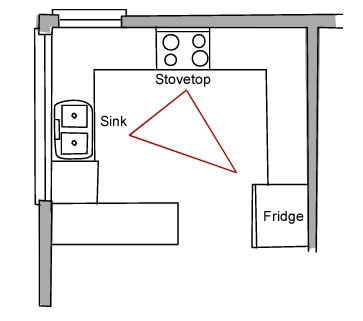
The kitchen work triangle – often just referred to as ‘the kitchen triangle’ – is a basic but time-honoured principle for designing ergonomic, functional kitchens. But is it still relevant?

What is the kitchen work triangle?
The kitchen work triangle – often just referred to as ‘the kitchen triangle’ – is a basic but time-honoured principle for designing ergonomic, functional kitchens.
The idea’s really simple: in an ideal kitchen, you should be able to draw a triangle between these three ‘work centres’:
- The kitchen sink
- The refrigerator
- The stovetop
These three areas represent, respectively:
- the place where you clean and prepare
- the place where you’re likely to store food, and
- the place where you cook
The second part of the kitchen work triangle rule relates to the distances between these three parts of the kitchen. According to the rule, three sides of the triangle should:
- be between 1.2 metres and 2.7 metres (i.e. between 4 feet to 9 feet)
- add up to a total of between 4 metres and 7.9 metres (i.e. between 13 feet and 26 feet)
What’s the rationale behind the kitchen triangle?
When you work in a kitchen, it’s likely that you’re going to have to do several different things to get a meal together – cleaning, preparing food and cooking among the most obvious and common.
The idea behind the kitchen work triangle is to clearly mark out distinct spaces (or ‘work centres’) for each of these fundamental tasks, and to plan an ergonomic work area to reduce the distance and effort required to work effectively in the kitchen.
The kitchen work triangle seems pretty simplistic…
You wouldn’t be alone in saying so. The kitchen work triangle’s taken a flogging in recent years by many kitchen designers who say it’s now more or less irrelevant.
To understand why, you need to know how the idea came about in the first place. The kitchen work triangle concept was first devised as a part of a design study by the University of Illinois School of Architecture way back in the post-war 1940’s.
Things were pretty different back then. Men were breadwinners, and would rather drink slow-acting poison than lift a finger in the kitchen. As well as baking on a pretty regular basis and growing her own veggies, mum would make packed lunches for everyone – and was probably a full-time homemaker.
Nobody ate takeaway, and in most cases nightly dinners rarely strayed too far from the humble comfort of meat and two veg. All meals were eaten fearfully and politely at the dinner table. Microwaves, dishwashers, food processors and similar devil tools hadn’t been invented, and in most households a wok was a spelling mistake.

Is the kitchen work triangle dead?
It’s easy to see how the changes in the way we use the kitchen have given fuel to the mounting arguments against the relevance of the kitchen work triangle as the main guiding principle in kitchen design. The types of foods we cook are different and require very different preparation. The tools we use to cook and prepare them are completely different too, as are our eating patterns in general.
And somehow over time kitchens have evolved into the unofficial core around which all social activity tends to centre. It’s not uncommon for two people to use the kitchen at the same time, or for people to eat in or around the kitchen.
Houses are now far, far bigger than they used to be as well – in fact, in Australia average house sizes have swollen by 40% in the past 20 years. Australia now has the largest average home size in the world (243 square metres). And accordingly, the space occupied by kitchens is now much larger.
The ‘work triangle’ was originally designed specifically for kitchens in fairly small houses, and while it still works pretty well in smaller apartment kitchens, a lot more consideration’s normally required for more elaborate designs featuring island benches and so forth.
Beyond the kitchen triangle
The kitchen work triangle still has a big role to play in kitchen design, but professional kitchen designers these days are likely take much more into consideration when they’re planning your kitchen layout.
Some of these things might include:
- how the kitchen can be used by two or more people at once – perhaps with a second sink to create two work triangles in the same kitchen
- whether people most commonly using the kitchen are left-handed or not
- how more commonly-used appliances need to be allowed in – perhaps even to create a rectangle or pentagon rather than a triangle
- where bins are positioned relative to preparation areas
- where the dishwasher is positioned in relation to the sink, and how close it is
- how much clearance there is around the three work centres (stovetops and sinks in particular)
- seating incorporated around the kitchen so that people can sit and chat or eat without interfering with busy cooks
- the likely prevalence of foot traffic around seating and work areas
- how the kitchen relates to other areas of the house, so that the cook isn’t shut away from the action like a leper
- how things like TVs and computers can be usefully and safely incorporated into the design
- arrangement of storage and bench space to best complement the way the kitchen will be used
- how the kitchen can be planned so that it can universally accommodate people with all sorts of needs, abilities and impairments
The work triangle’s as close as it gets to a ‘one size fits all’ way to design kitchens, but it’s by no means the only design consideration that should be taken into account. For a better idea of what kind of kitchen’s going to suit your household best, have a chat with a professional designer. There’s a surprising amount of thought goes into a good kitchen, and if you’re planning on spending any amount of time cooking, it’s well worth it.
Need some design inspiration? Browse through some of Australia’s best kitchens in our kitchen ideas gallery.





